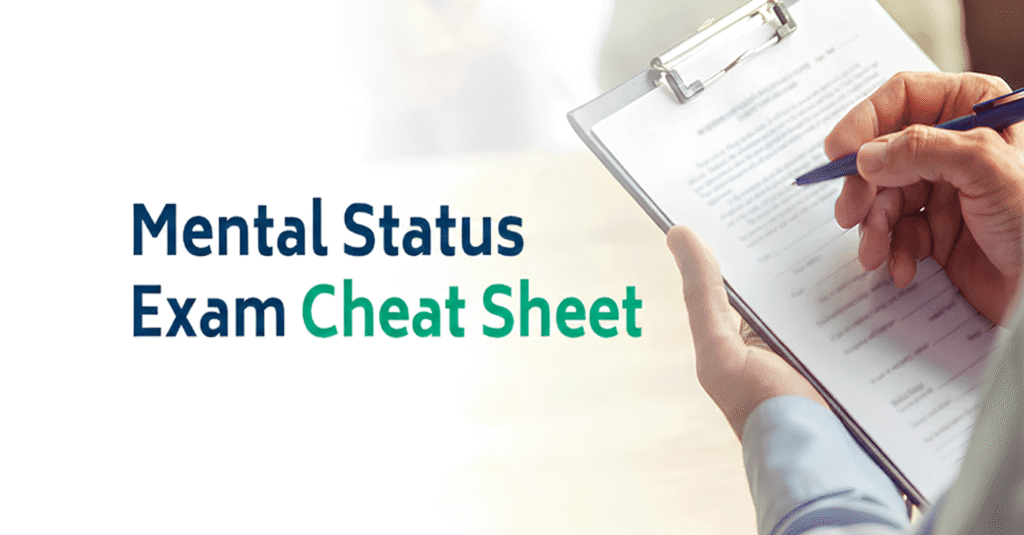Why a Mental Status Exam Cheat Sheet is a Lifesaver
If you’ve ever stared at a psychiatric evaluation form and thought, “Wow, this looks more complicated than my grocery list,” you are most definitely not alone.
The Mental Status Exam (MSE) is one of the most essential tools in psychiatry, psychology, primary care, and emergency medicine. But here’s the problem: despite its importance, it can feel overwhelming. There are so many moving parts to remember—appearance, attention, affect, thought content, judgment, and more.
Here’s the good news: you don’t need to memorize giant textbooks or carry around three different board review manuals. A clear, practical mental status exam cheat sheet makes everything easier—improving accuracy in real‑world practice, reducing exam panic, and helping you finish notes faster.
In this comprehensive 2025 guide, we’ll:
- Break down the MSE into step‑by‑step domains
- Share real‑world examples that bring the concepts to life
- Provide checklists and comparison tables for quick recall
- Include 2024–2025 updates from clinical guidelines and global research
By the end, you’ll have a cheat sheet that doubles as a clinical safety net and a confidence booster.
What Exactly Is the Mental Status Exam (MSE)?
Think of the MSE as the psychiatric equivalent of a physical exam. Instead of checking reflexes or auscultating lungs, you’re checking:
- Is the patient’s mood congruent with their affect?
- Does their thinking make sense (process) and what are they actually thinking about (content)?
- Are they oriented to person, place, and time?
- Can they remember, pay attention, and reason abstractly?
In short: the MSE is a clinical snapshot of a person’s emotional, cognitive, and behavioral functioning at the moment of the exam.
It is structured, clinically useful, and timeless. Even with AI‑driven tools, digital health monitoring, and advanced biomarkers on the horizon, the MSE endures because it captures nuance and humanity in a way screens cannot.
Why Clinicians (and Students) Struggle with the MSE
- Breadth: It covers 8–10 domains, and you’re supposed to remember them all—on the fly.
- Hybrid nature: It mixes objective observations (your exam) with subjective reports (what the patient says).
- Performance anxiety: In exams or on psychiatry rotations, you may feel pressured to recall every bullet point like a machine.
That’s why a clear, structured cheat sheet is so valuable—it organizes the moving parts into a systematic flow and keeps anxiety out of the way.
Step‑by‑Step Mental Status Exam Cheat Sheet (Practical & Updated)
Here’s the bedside‑friendly format you can print, save on your phone, or quietly whisper to yourself on rounds.
1. Appearance & Behavior
Key things to check:
- Age, grooming, dress (appropriate for season/culture?)
- Posture, eye contact, motor activity
- Attitude toward interviewer (cooperative/hostile/guarded)
Quick terms to document:
- Hygiene: disheveled, well‑groomed, meticulous
- Psychomotor: slowed, agitated, normal
- Attitude: evasive, defensive, cooperative
Example: A 24‑year‑old arrives in winter with shorts and a torn T‑shirt, pacing in the waiting area and averting eye contact → “Disheveled, psychomotor agitation, avoidant, guarded.”
2. Speech
Evaluate:
- Rate: rapid, pressured, slowed, normal
- Volume: loud, soft, monotone
- Fluency/articulation: slurred, stutter, clear
- Coherence: tangential, circumstantial, poverty of speech
Examples:
- Manic state → pressured and hard to interrupt.
- Severe depression → delayed, whisper, short responses.
3. Mood vs. Affect
Definitions to lock in:
- Mood (subjective): how the patient says they feel.
- Affect (objective): how emotions appear externally.
Descriptors: full, restricted, blunted, flat, labile, incongruent, appropriate.
Example: Patient reports “I’m fine” but sits teary‑eyed with minimal responsiveness → sad mood? incongruent affect.
4. Thought Process vs. Thought Process
Thought process = how they think
Logical, goal‑directed, circumstantial, tangential, flight of ideas, loose associations, incoherent.
Thought content = what they think about
Delusions (grandiose, persecutory), paranoia, obsessions, phobias, suicidal or homicidal ideation.
Comparison Table:
| Thought Process | Example | Content | Example |
|---|---|---|---|
| Flight of ideas | Rapid switching, mania | Grandiose delusion | “I am chosen to lead humanity.” |
| Tangential | Never returns to question | Paranoia | “Neighbors installed cameras in my walls.” |
| Circumstantial | Over‑detailed, eventually answers | Suicidal ideation | “I sometimes think about overdosing.” |
5. Perceptions
- Hallucinations: perception without stimulus (auditory > visual > tactile).
- Illusions: misinterpretation of real stimulus.
- Depersonalization: detachment from self.
- Derealization: world feels unreal.
Always probe if hallucinations are commanding harm to self/others → immediate safety issue.
6. Cognition
Standard 4 buckets:
- Orientation: person, place, time.
- Attention: serial 7s, spelling backward, months backward.
- Memory: immediate (3 words recall), recent (today’s meals), remote (personal history).
- Abstract reasoning: interpret proverbs, compare objects.
Evidence update (2025): MoCA outperforms MMSE for catching mild cognitive impairment, so many clinicians now prefer MoCA during cognitive‑heavy workups.
7. Insight & Judgment
- Insight: Does the patient recognize symptoms/problems?
- Judgment: Can they make safe, appropriate decisions?
Examples:
- Poor insight: denies need for substance use treatment despite daily use.
- Poor judgment: plans to drive while intoxicated.
8. Safety (Pro tip: Always Add This Extra Domain)
Outside of exams, clinicians never skip safety:
- Suicidal ideation? plan? intent? means?
- Homicidal ideation?
- Command hallucinations?
- Capacity to consent/refuse treatment?
Quick One‑Page MSE Checklist
✔ Appearance & behavior
✔ Speech
✔ Mood & affect
✔ Thought process & content
✔ Perceptions
✔ Cognition
✔ Insight & judgment
✔ Safety risks
Clinical Relevance in 2024–2025
- Global burden: WHO (2023) estimates >1 billion people live with mental disorders.
- Economic impact: Depression & anxiety cost ~$1 trillion/yr in lost productivity (~12 billion workdays).
- Telepsychiatry adaptations: APA guidelines (2024) highlight tips: video framing, prompting for facial cues, documenting limits of virtual exam.
- Early intervention: Multiple 2023–2025 trials show structured early screening reduces hospital readmissions by ~18% in high‑risk populations.
FAQs: Fast Voice‑Search Friendly
1. What’s the purpose of the MSE?
Provide a structured snapshot of current mental functioning → guides diagnosis and safety planning.
2. How long does it take?
5–15 minutes for focused exams; longer if adding cognitive screeners or deeper psychopathology exploration.
3. Is it objective or subjective?
Hybrid—your observations + patient self‑report.
4. Can non‑psychiatrists use it?
Yes—PCPs, ER docs, psychologists, social workers, nurses, and students use it daily.
5. Difference between MSE vs MMSE/MoCA?
MSE = broad (mood, thought, behavior, safety).
MMSE & MoCA = narrower (cognition only). Montreal Cognitive Assessment (MoCA) is more sensitive for mild cognitive impairment.
Bedside Memory Hacks
- ABCD: Appearance, Behavior, Cognition, Disorders of thought.
- ASPEECH‑J: Appearance, Speech, Perception, Emotions, Executive/cognition, Content, Harm/safety, Judgment/insight.
- Print a one‑pager → repetition builds fluency.
Final Thoughts: Your Pocket Map Through the Psychiatric Maze
The mental status exam might feel intimidating, but with this cheat sheet it quickly becomes second nature. From depression screening in primary care to hallucination probing in psychiatry, the MSE provides a systematic, clinically powerful framework for making sense of complex presentations.
In 2025, despite AI apps, digital platforms, and cognitive screeners, the MSE remains your most human, nuanced, and versatile tool. Keep the checklist on your phone, rehearse it with every patient encounter, and adapt it confidently to both in‑person and telehealth settings.
Remember: it’s not about memorizing jargon—it’s about building clarity, structure, and clinical confidence.
Master this roadmap, and you’ll never panic when someone says: “Please perform a mental status exam.”

